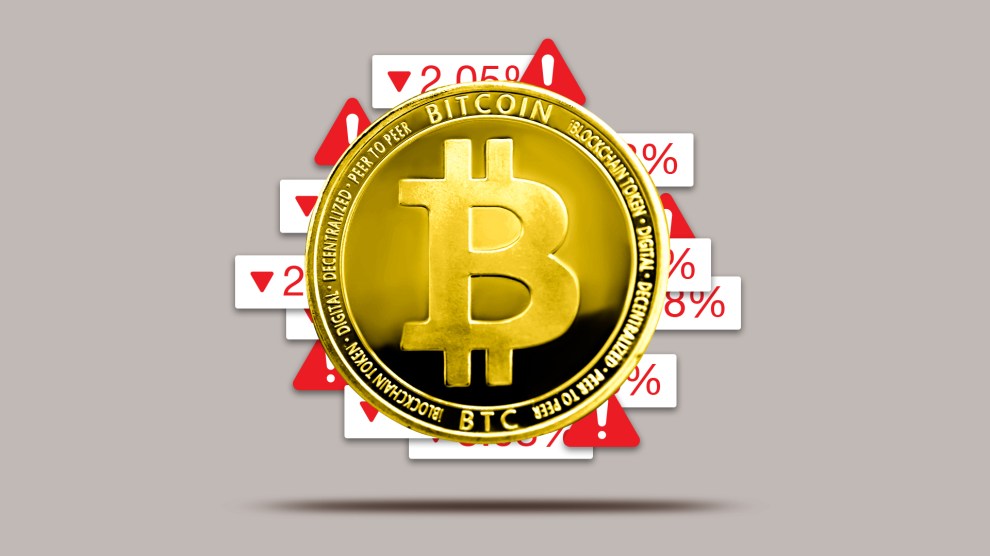When Crypto Crashed, Coinbase Stopped Some Alerts – Mother Jones


Mother Jones illustration; Getty
Back in November In 2021, cryptocurrencies, which saw a huge increase during most of the pandemic, suddenly began to take a dive. Joe Hovde, a New York-based computer scientist decided that this could be his moment to buy into crypto: He took a risk on the price rise and bought Ethereum, the second most popular crypto asset after Bitcoin, on Coinbase, a crypto exchange.
A couple of months later, Hovde started getting emails from Coinbase notifying him of fluctuations in the prices of Ethereum, Bitcoin and other tokens. “Price Alert: Ethereum (ETH) is down -4.90%” read the subject line of one. The body of the email greeted Hovde (“Hey Joe”) and elaborated on the current price of Ethereum and the timing of the fall -4.9%: It had happened in the last 12 hours. Although already a steady consumer of financial news and current events, Hovde used the alerts to passively monitor his investment while juggling other things. So when crypto assets began to take another dive in April 2022, Hovde noticed that at some point the emails seemed to stop coming.
Head, like hair worked on projects that picked out trends and patterns from large datasets for both technology companies and Media, scraped his inbox and confirmed that he hadn’t received price alerts by email from late February until they started up again in early June; during that time period, Bitcoin, Ethereum, and other currencies lost dozens of percent in value in thousands and tens of thousands of dollars.
Coinbase’s decision to stop email notifications the middle of one dramatic cryptocurrency crash has not been reported previously. But academics who spoke to Mother Jones Note that Coinbase’s decision likely contributed to losses for private crypto investors who may otherwise have sold their holdings ahead of further devaluation. The change to price updates could run afoul of federal or state consumer protection laws, they said, especially if it hurts the wallets of some of the relatively inexperienced traders which flocked to crypto in droves during the pandemic
Coinbase verified to Mother Jones that it began testing email price alerts in January on a subset of customers, but declined to elaborate on what proportion of users were in the test pool. The company explained that it halted this test around February, temporarily halting notifications before reintroducing them to all users several months later. Based on Hovde’s emails and posts on social media by people who received the emails, it appears that the alerts were introduced to all users in June, meaning there was a likely gap in price updates this spring from February to May.
“We began testing email alerts for some users in January and have since rolled out email alerts for all interested users,” Coinbase spokeswoman Crystal Yang said in an emailed statement. She did not elaborate on when emails were turned off and then on again.
Hovde said he received no notice that the email service was being discontinued, and there are no entries on Coinbase’s blog about the change. Coinbase did not respond to questions about whether it had notified users in the test pool before stopping its notifications.
Hovde’s portfolio was not significantly affected by the discontinued notifications, he says, but ethics experts worry about those that might be.
“It’s potentially illegal,” said Matthew Bruckner, an associate professor at Howard University who specializes in business law. Mother Jones. Bruckner suspected that the practice may have been in violation of the Unfair and Deceptive Practices or UDAP Acts, which are state regulations that prohibit the deception of consumers. “It might be unfair to do this, to kind of make people rely on the email alerts,” Bruckner explained, saying that if Coinbase started and stopped email alerts without properly notifying users, and that this was proven to have “caused significant harm” such as financial loss, which may pose a problem.
“This seems downright misleading,” he said. “They said we would email you price alerts and then they stopped doing it without saying they were [going to stop].” Depending on what Coinbase promised and communicated to users, Bruckner said affected users could have grounds to sue Coinbase if users who received the emails stopped checking cryptocurrencies elsewhere, causing them to lose out when prices began to fall just like emails.disappeared. “It seems plausible that they could have caused harm by getting users to stop using other methods of checking prices by introducing price alerts by email, and then taking them away.” But Bruckner added the reminder that more detail would be needed about exactly what assurances Coinbase gave users who received the email alerts. In an email, Coinbase declined to comment on the issue of any legal issues raised by its email alerts.
Bruckner also noted that while Coinbase wasn’t sued, it’s not necessarily clear. “If they caused harm to people who weren’t selling crypto that they would have sold, that could potentially be acted upon by regulators,” depending on the size of the sample of users tested, he said.
Benjamin Edwards, an associate professor of law at the University of Las Vegas Nevada, said Mother Jones via e-mail that some state UDAP laws include provisions that explicitly prohibit companies from misleading consumers through the omission of material information — such as failing to tell customers about the end of price update e-mails just as the crypto market rallied.
“It would not surprise me to see arguments that Coinbase’s failure to notify customers that it will arbitrarily stop providing price alerts during a market downturn constitutes a material omission,” Edwards said. “Some of these customers may have closed their positions earlier if Coinbase had notified them.”
Edwards also noted that if a traditional brokerage firm had done this, they would likely have been penalized by the Financial Industry Regulatory Authority (FINRA), a private self-regulatory organization for financial institutions. Cryptocurrency exchanges and cryptocurrencies are regulated, but the question of which agencies should have jurisdiction over them is still being hashed out, meaning the industry is still not as closely scrutinized as traditional finance.
“When [Coinbase] promises things like price alerts to customers, it does this to make itself an attractive trading venue,” Edwards said over email. If clients rely on the price alerts to inform their trading decisions, then “It is not a fair business practice to suddenly change the rules without notice to customers.”
In response to questions about whether it may have violated UDAP laws by quietly pausing price updates, Coinbase spokesperson Crystal Yang said in an email that “All Coinbase customers have the option to be notified of certain asset price changes on their watchlist through push and in-app notifications.” She added that even when email notifications were paused, “users continued to receive push and in-app notifications, if selected.”
Thoughtful investing takes time, and people with the shortest amount of money often have the least amount of time to spend watching markets and following financial news. This can make them special likely to act on the communication they receive from the platforms where they invest.
In August 2021, for example, Coinbase accidentally sent an email to 125,000 users telling them their two-factor authentication settings had changed, leading users to believe their accounts were compromised. At least one claimed that they had sold crypto in response to the alert to avoid what they thought was a hack.
Price updates, especially on a volatile asset that is subject to aggressive fluctuations, can be useful for those who do not have the ability to keep up with the details of the markets, helping them make sound decisions about their investments to avoid heavy losses.
From April 3 to 5, for example, the price of Ethereum fell by 10 percent. Days later, from April 9 to 10, it fell another 7 percent. It is conceivable that notices of these significant price drop could have prompted an investor to sell and helped them avoid thousands of dollars in losses over the coming months: Ethereum began a steep and sustained decline in May which cut the value by 66 percent.
Not everyone agrees that price alerts are good for consumers. James Tierney, a law professor at the University of Nebraska College of Law who focuses on stock market regulation and corporate law, argued over email that increased push notifications could hurt investors.
“App designers use push notifications and other practices to keep our attention engaged, and that’s true in trading and portfolio apps as well,” he told me. “But ordinary people often don’t benefit from having our attention focused on commerce.” Research, he pointed out, shows that unsophisticated retail investors often undermine their own portfolios by trading frequently, rather than holding investments for long periods.
One solution might be to limit notifications of all kinds—email, push, or otherwise—or never make them available to begin with. But apparently inconsistent offers deprive users of the information they think they are getting and give them the worst of both worlds.
























